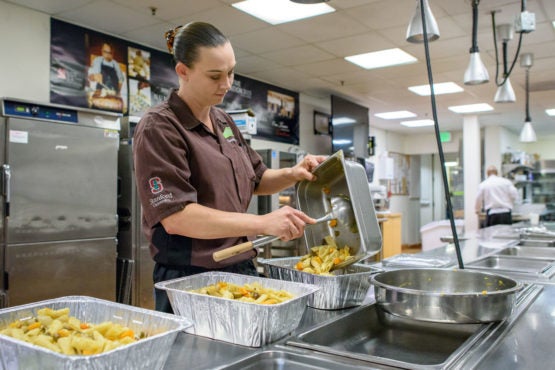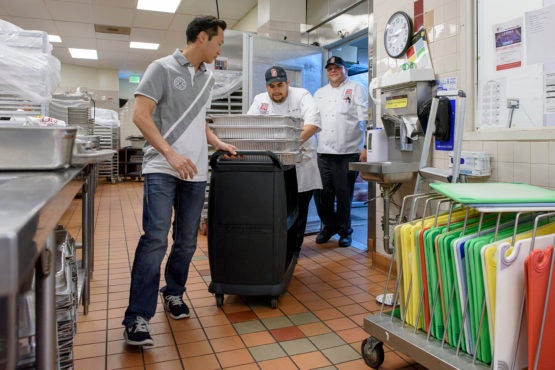Stanford donates surplus food to community groups under campus-wide program
Stanford’s Residential & Dining Enterprises, which established its first food donation program at Schwab Residential Center more than seven years ago, has expanded the program to include dining halls across campus.
When Samantha Snyder opened the warming oven in the kitchen at the Schwab Residential Center, she found silver trays filled with leftovers: penne pasta, barley with baby kale, and turkey stuffed with goat cheese, spinach and roasted peppers.

On a recent summer afternoon, Samantha Snyder, a food service worker in the Schwab Residential Center, scooped tasty lunch leftovers into aluminum hotel pans. After weighing and labeling the pans, she stacked them in the freezer, ready to be picked up by volunteers working for local community organizations that feed hungry people. (Image credit: L.A. Cicero)
Snyder, who has worked for Stanford Dining for three years, knew from experience that the dishes were perfect candidates for its food donation program because they would still be tasty after they had been frozen and reheated.
So she scooped the food into aluminum hotel pans, and after weighing and recording the data on the kitchen’s food waste metering system, labeled the trays and stacked them on a shelf in a walk-in freezer. The next day, a volunteer with the Kiwanis Club picked up the food, which would be served that evening at St. Francis of Assisi Church in East Palo Alto.
It is a routine that happens every week in residential dining halls across campus – surplus food from buffet-style breakfasts, lunches and dinners is packaged, weighed and frozen for pickup by volunteers working for community organizations that feed hungry people, including churches, homeless shelters, senior centers, social service groups and neighborhood centers.
“We have a responsibility to be good stewards and to minimize waste,” said Shirley J. Everett, senior associate vice provost of Residential & Dining Enterprises.
“Given our experience, even the most efficient dining operations will produce some excess food. This program allows us an opportunity to support the community by donating to our neighbors in need.”
Minimizing excess production
While R&DE has established programs to donate leftover food to community organizations, its top priority is reducing the volume of surplus food generated at the source, said Eric Montell, executive director of Stanford Dining.
“We want to make sure that the amount of food that we’re buying and producing doesn’t in and of itself produce waste,” he said, adding that Stanford Dining uses LeanPath food waste tracking terminals to weigh, categorize and analyze surplus food generated in its kitchens.
“Source reduction” is also the top tier of the U.S. Environmental Protection Agency’s “Food Recovery Hierarchy,” which ranks actions organizations can take to prevent and divert wasted food from “most preferred” to “least preferred,” based on their impact on the environment, society and the economy. “Feed hungry people” is second on the tier, followed by “feed animals,” “industrial uses” and “compost.” “Landfill/incineration” is considered a last resort.
“There will always be some small amount of surplus food at the end of a dining hall meal, given that we serve buffet-style meals, but it is not our intent to create food to be donated,” said Montell, noting that Stanford Dining serves 12,000 meals a day.
“It is our goal to be fiscally responsible and provide high-quality meals for Stanford students to eat in the dining halls. We also want to support these important community service programs whenever possible.”
Food donation programs on campus
Stanford’s Residential & Dining Enterprises (R&DE) established its first food donation program more than seven years ago at Schwab, which caters to visitors conducting university-sponsored business with the Graduate School of Business.
R&DE now operates food donation programs in each dining hall.
“Over the years, we’ve really scaled the program, in part because there is huge interest among students,” said Dara Silverstein, manager of R&DE’s Sustainable Food Program. “The No. 1 email question I get from students is ‘Do you do food donation? If not, here’s this program or this app that I found about food donation.’”

David Ko, (left) a pastor at Wesley United Methodist Church in San Jose, picks up frozen food leftovers that will be reheated and served at a weekly dinner for low-income Hispanic families. Ko, who earned a master’s degree in international comparative education at Stanford in 2014, guides the donated food through the Stern Dining kitchen with the help of Emerson Erazo, Jr. (center) and Jose Diaz, food service workers in Stanford Dining. (Image credit: L.A. Cicero)
Silverstein said the program has grown with the help of student interns, as well as students involved in Students for a Sustainable Stanford, which strives for long-lasting sustainable practices on and off the Stanford campus, and The Stanford Project on Hunger (SPOON), a student group that collects food on campus for donation to community organizations.
In addition to collecting food from dining hall meals, Stanford donates leftover food from special events, such as Midnight Breakfast, which is held during winter quarter at student dining halls, and the recent Multicultural Springfest, an annual staff event that was held in Stanford Stadium. This summer, R&DE is launching a pilot food donation program with Stanford Conferences, which hosts more than 200 youth and adult programs each summer.
In June and December, when students leave campus and the kitchens shut down, volunteers from the Ecumenical Hunger Program in East Palo Alto and Wesley United Methodist Church in San Jose collect boxes of produce and food that cannot be used from campus kitchens, including fresh fruit and vegetables, and the unopened, packaged food students don’t want to take home, such as granola bars, tea, coffee and oatmeal.
The Med Café in the Li Ka Shing Center of Stanford Medicine and Catering at Li Ka Shing recently joined R&DE’s food donation program. Volunteers from Peninsula Food Runners now make regular pickups of surplus food from the café and the catering service and relay it to community groups in San Mateo and Santa Clara counties.
This summer, Stanford will begin donating fresh surplus food, twice a day, from its dining halls and cafes. The Faculty Club, although not a part of R&DE, will also participate. Under the pilot program with Silicon Valley Food Rescue, volunteers will collect food in refrigerated trucks, and then disburse it to residents in Mountain View who are struggling to feed themselves and their families.
“We want to make sure our surplus food goes to the appropriate places and is delivered in the most efficient and effective way,” said Montell.
Student efforts
Christopher LeBoa, a Stanford junior majoring in human biology, has been active in food recovery on the Farm since his first year on campus, including a stint as an intern with R&DE’s Sustainable Food Program.
“Our student ID cards give us access to dining halls and cafes that greet us every day with platters and trays piled high with food,” said LeBoa, who is the co-director of Students for a Sustainable Stanford. “I hate to see food going to waste at Stanford, especially when there are so many hungry people living in communities around our campus. That’s why I got involved here, trying to get donations of surplus food from cafes, dining halls, co-ops, Row Houses and from athletic events. It’s our responsibility to give back to those who have less.”
This year, in collaboration with Sustainable Stanford, the student group launched a pilot program to recover surplus food from concession stands at athletic events, offering two free tickets to the event to students – known as “food runners” – who help collect and distribute the food to community organizations after the event.
Currently, the student group is collaborating with Second Harvest Food Bank and Student Organized Services to place 22 barrels around campus in June to collect the leftover unopened food students have in their dorm rooms to donate to community groups.
